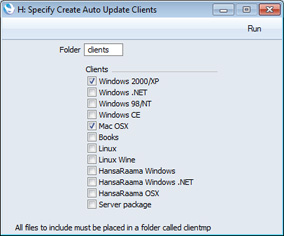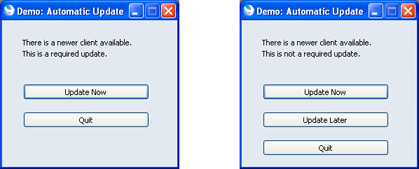Updating to New Versions of Enterprise by HansaWorld - Updating Clients Automatically
When you update to a new version of Enterprise by HansaWorld, you should ensure that you are update to the same new version on the server and on all client machines. If you have many client machines in your network, updating them manually can be a laborious job. To make this task easier, you can use the auto update feature that will cause the version on the client machines to be updated automatically the next time they connect to the server.
To configure the auto update feature, follow these steps:
- By default, the auto update feature will transfer the new client applications through port 80 on the server. Opening this port might be undesirable and also requires superuser privilege in many systems. If you want to use a different port, create a text file named "serverip.dat" that contains the server's IP address and Web Port in the following format, on a single line:
- IP address:port
Note: do not place any carriage returns or any other characters after the port.
You can find the server's Web Port by opening the Program Mode register in the Technics module and going to the 'Web' card. If you need to specify a Web Port on the server or change the one that is there, you will need to restart the server for the change to take effect.
- Place the "serverip.dat" file in the "Hob" folders on every client.
- Set up a new Enterprise by HansaWorld installation on a client machine, with no database (no .hdb file). Create a folder or directory named "clientmp" and place it in the folder containing the Enterprise by HansaWorld application.
- Inside "clientmp", create one sub-folder or sub-directory for each client platform that you need, as follows:
| Folder | For Client | Application Name |
| books | Books Mac | Books.app |
| hansaraamaosx | HansaRaama Mac (only used in Estonia) | HansaRaama.app |
| hansaraamawin | HansaRaama Windows (only used in Estonia) | HansaRaama.EXE |
| hansaraamawindowsnet | HansaRaama Windows .Net (only used in Estonia) | HansaRaama.EXE |
| linuxxt | Linux XT | HansaWorld |
| linuxwine | Linux Wine | HansaWorld.EXE |
| macosx | Mac OS X Cocoa | HansaWorld.app |
| win98 | Windows 98/NT | HansaWorld.EXE |
| wince | Windows CE | HansaWorld.EXE |
| windows | Windows 2000/XP | HansaWorld.EXE |
| windowsnet | Windows .Net | HansaWorld.EXE |
This feature is not supported on Windows 7 clients.
- Copy the following files into the sub-folders or sub-directories from step 4:
- The "DBDEF.TXT" and "DEFAULT.TXT" files;
- The new version of the relevant Enterprise by HansaWorld application for the operating system. This must be named as shown in the list in step 4 (the names are case-sensitive). Depending on how you have configured your operating system, the file extensions may not be visible.
- The new "Hob" folder (which should contain the "serverip.dat" file from step 1, as this will ensure you don't need to repeat step 1 each time you update); and
- (optionally) a file named "AUTOUPDATEIMPORT.TXT", which can contain information that will be imported to each client database.
- The "windowsnet" folder should also contain the following files: "Boo.HtmlEditor.Shared.dll", "ColorPicker.dll" and "HtmlAgilityPack.dll".
- Create a folder or directory named "clients" in the folder containing the Enterprise by HansaWorld application that you are using.
- Start the Enterprise by HansaWorld application, change to the Database Maintenance module. To gain access to the Database Maintenance module, grant yourself full access to it in your Access Group and log in again.
Run the 'Create Autoupdate Clients' Maintenance function:

Tick the Client options that you need (each option should have its own folder as listed in step 4), specify the Folder (if different to step 6) and click the [Run] button.
The Maintenance function will create separate .ha files for each Client options, saving them in the "clients" folder (for example, "windows.ha", "windowsnet.ha" and "macosx.ha").
- On the server machine, create a folder or directory named "web" in the folder containing the Enterprise by HansaWorld server application.
- Copy the entire "clients" folder (containing the .ha files) into the "web" folder created in the previous step.
- Update your Enterprise by HansaWorld server application to the new version as described here, and then launch this application as normal.
- Log in from a client using the new version and change to the Technics module. To do this, you should be working on a client and you should have logged in as a system administrator (i.e. as a Person that has access to the Technics module) as described here.
Open the Available Client Version setting in the Technics module:

Enter the version number of the server application in one or both of the fields. When a client logs in using a version that is earlier than the one specified in these fields, the client will be asked to update. If the client version is earlier than the Minimum Client Version, the update will be mandatory. If the client version is earlier than the Available Client Version, the update will not be mandatory.
In most cases, it is recommended that you make updates mandatory, as shown in the illustration. This will ensure that all client machines are using the same version.
If the new version contains structural changes compared to the old, the update will be set as mandatory automatically, irrespective of the field that you use in this setting.
The version number of the server will be shown in the Terminal window when you launch the server and will be written to the log file at the same time.
It is now possible for the clients to log in, as follows:
- On a client machine, launch the old Enterprise by HansaWorld client application.
- After choosing the company, you will be told that a newer client is available, and whether the update is mandatory:

- Click the [Update Now] button. Your client application will be updated, as follows:
- Your client database will be backed up;
- The new client application, "Hob" folder and any other files will be downloaded to your client folder;
- The old client application, "Hob" folder, database and other files will be moved to a folder named "oldver"; and
- The new client application will be launched and the client text back-up imported.
- Log in as normal.
---
In this chapter:
Go back to:
